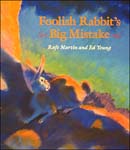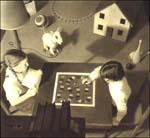Media of Picture Books - Part III
I. Pastels
Pastels can be a chalk-like substance or they can be oil-based crayon. Pastels can produce dramatic pictures such as Ed Young's in Foolish Rabbit' s Big Mistake.


Stephen T. Johnson worked with pastels in his illustrations for Hoops. The effect is dramatic, giving the snapshots of soft, swift and swirling movements of basketball. See the cover image from this Web site: http://www.amazon.com/gp/reader/0152014500/ref=sib_dp_pt/002-9602817-2688837#reader-link
J. Soft Pencils
Being a soft material, soft pencils cannot create the sharp lines that hard pencils of pen-and-ink can create. So the effect tends to be ethereal and mysterious. Stephen Gammell used a soft pencil to make the drawings for Where the Buffaloes Begin. You were not required to purchase this book; take a moment to visualize the concept.
Peter McCarty used soft colored pencils to create the illustrations for Hondo and Fabian.
![]() Go to the Web Resources link for Hondo and Fabian to see images and get more information.
Go to the Web Resources link for Hondo and Fabian to see images and get more information.
K. Hard Pencils
Chris Van Allsburg used a conté pencil, a hard drawing pencil to make the illustrations for Jumanji. By sandpapering the pencil, he created dust that he worked back into the pictures, giving them a mysterious quality.


L. Mixed Media
The last 20 years of picturebook creation has been marked by much experimentation. As such, many, many recent picturebooks have been created using a combination of media. As illustrators search for new ways to create illustrations for stories that evoke just the right feeling, they try mixing media. Rosemary Well' s Yoko' s Paper Cranes is a good example of an illustrator combining several kinds of media to create a mood appropriate to the story. The story is about a little girl, born in Japan, but living in California, who decides to make and send origami cranes to her grandmother. Wells used origami and washi papers, gold leaf, rubber stamps and paint to create the warm, tender pictures.
![]() Also, go to the Web Resources link for Yoko's Paper Cranes to see images and get more information.
Also, go to the Web Resources link for Yoko's Paper Cranes to see images and get more information.
Christopher Myers, in Black Cat, captured the neon energy of the city by creating collages out of photographs and then painting over them while also working in some pen-and-ink.
![]() Go to the Web Resources link for Black Cat to see images and get more information.
Go to the Web Resources link for Black Cat to see images and get more information.
Sometimes illustrators use different media to portray how different characters view the events of the story. John Burningham is particularly effective in using this technique. In Come Away from the Water, Shirley, he draws Shirley's parents in simple colored pencil sketches with lots of white space left around the picture on the left side of the double-page spread. On the right side of the opening, Burningham paints Shirley in thick tempura paint that bleeds to the edges. The contrast is striking. Coupled with the sparse text, the illustrations suggest that while Shirley's parents live in a rather dull world, Shirley sees the world as full of possibilities for imaginative play.
![]() Be sure to look at
your copy of Come Away from the Water, Shirley to see this demonstrated.
Be sure to look at
your copy of Come Away from the Water, Shirley to see this demonstrated.
